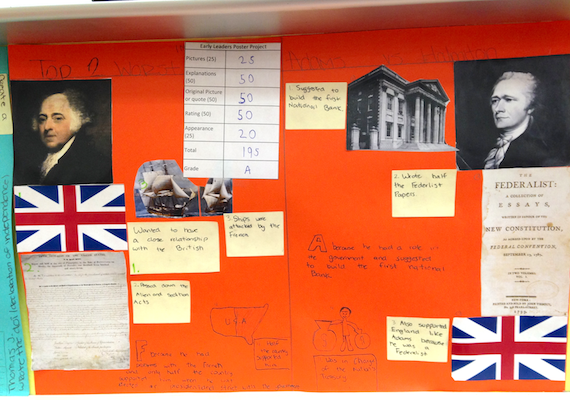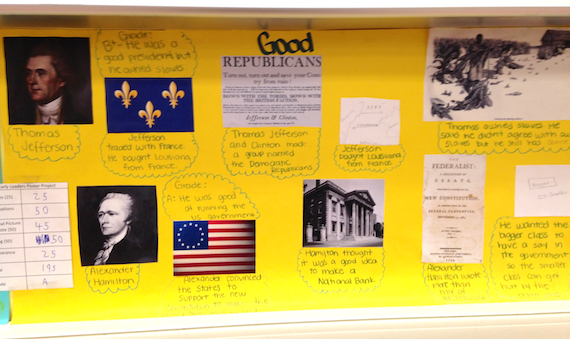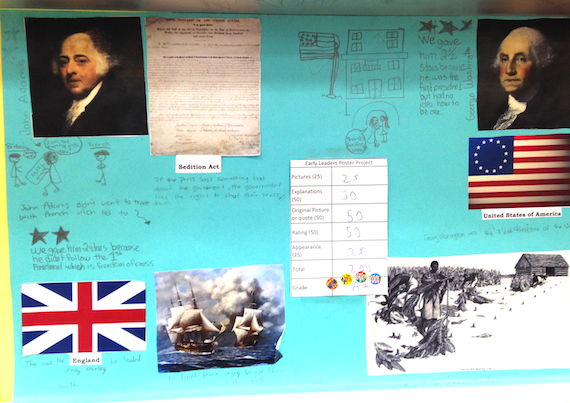History Poster Projects as Assessment Tools

Theoretically, this is all well and good. However, there is a great deal of pressure to make all classrooms academically rigorous at all times. In public schools, this can mean a teacher must constantly defend any decision to incorporate art, performance and other less traditional elements into an assessment. There is also the possibility that students will not take an assessment seriously if they do not feel that it is a “real” assignment.
This year I experimented with a poster project as an assessment. What follows is a description of the project itself, the rationale behind its various elements, and some reflection on its efficacy as an assessment.
The project overview
My students completed this assessment at the end of our Early American Leaders unit. Students had been reading and writing about the successes and failures of George Washington, Alexander Hamilton, John Adams and Thomas Jefferson. Working in teams of 2-4, students created two posters: one poster with the two “best” leaders of the early United States, and one poster with the two “worst” leaders of the early United States.
Each group had to decide for themselves who the best and worst leaders were. I provided printed portraits of each leader to help them visually arrange the men in question as they debated their successes and failures. I also gave students a dozen pictures that represented the interests and achievements of the leaders. The student teams had to puzzle out which pictures went with each leader, and then justify their placement of each picture. These explanations had to be supported by evidence from the texts we’d read during the unit.
After arranging the presidents and the pictures, students were required to add a picture of their own, representing an event related to that leader that was not included in the pictures I provided. This had to be original artwork and had to be explained using textual evidence.
Finally, each team had to create a rating system to rank the leaders from best to worst. This could be a number of stars (like a film rating), a letter grade, or some other less conventional ranking system, so long as it was clear. Each rating had to be explained based on evidence from the text, and the views of every member of the student team.
My teaching rationale
The most important aspect of this assessment was that students had to make meaningful choices at every step. From the beginning, students had to decide who did well as an early leader and who did poorly. The students with the strongest opinions were the ones who had best understood what they read. It was often clear which member of each student team had understood the texts by their ready defense of their opinions about the best and worst leaders.
The printed pictures also forced students to evaluate what they had read and make choices. Most students were under the impression that there were “right” and “wrong” placements for each picture, and tried to get me to give away the “answer.” Each time this happened I referred them back to the texts and asked that the students locate a specific reason for any given placement.
If students found a rationale for placing a picture somewhere I had not considered, I treated it as valid. For example, the pictures included four flags: two Union Jacks, one 18th century French flag and an early U.S. flag. Most students placed the British flags with Adams and Hamilton, because they were federalists. A few teams, however, chose to place the British flag with Jefferson because the Embargo Act was in response to British attacks on American shipping. The purpose of the pictures was not to see if students knew the “right” answer, but rather to determine if students were learning how to support their answers with evidence from the text.
The ranking system at the end of the project was intended to get students thinking in broad strokes. Most of my students continue to think of history as a series of disjointed facts rather than an interpretable narrative. My goal was to have each team discuss the entire story told by their poster, and distill that story into one or two essential themes.
Reflecting on the project
Was my project an unmitigated success? No. But the results were consistent with other assessments I have given previously, and I am certain that students learned more during this project than they have when taking more traditional exams. Even the students who ultimately failed commented during the process about how they were starting to “get it” with respect to the overall story told in their texts.
That was probably the most illuminating aspect of this entire experiment for me. While I will continue to give tests that require the students have some knowledge memorized, this forced me to reflect on whether that is the most important way to check for understanding.
Going back to the texts a dozen times with specific goals in mind helped many of the students comprehend the texts, and a large portion of my students can, months after the assignment, cite specific evidence as to why Adams was, in their opinion, a bad president. The notion that “learning time” and “assessment time” must be separated feels significantly more arbitrary now.
As I have indicated in other MiddleWeb posts, most of my students read significantly below grade level when they come into eighth grade, and many also struggle with evaluative writing. The assessments planned by states adopting the Common Core Standards are going to be heavily weighted toward written response questions. Students will be expected to read one or more texts, and then make an argument supported by evidence from those texts. Assessments that give students practice with these skills will be preparing them for these tests, as well as providing useable literacy skills that can be used in college or the workplace.


































Hi Aaron:
I love this idea. It is similar to something I have done in the past as part of my “Growing Nation” unit. One issue I have run into is students who completely misinterpret a text. For example, they will read a criticism of the War with Mexico and come away thinking the person was from Mexico (the person was Abraham Lincoln…). How much time do you spend going over text with students to be sure they understand what they’re reading? Or perhaps a better question would be, what strategies are you using to help students understand what they’re reading?
I am not sure what demographic you are working with, but the average 8th grader in my class reads at about the 5th grade level (the median is probably closer to 3rd or 4th grade). So, just to be clear, helping students understand what they read is something that takes all year, and never happens for easily half my students.
That being said, we read all of the texts in class (I require that they read out loud in small groups most of the time), and there are always specific tasks that go with each reading (annotation, graphic organizers, notes). The project itself is intended to help with comprehension. One of the reasons I select most of the pictures the students use for the poster is to provide students with a specific reading task. Struggling readers will often do better when they reread a text with a discrete goal in mind.
Obviously, this is not a panacea, and it may not even apply to your students. If your students are, for the most part, reading at grade level, I would say that annotation or some other active participation with the text would be an important step to avoiding misinterpretation of a text.
Hi Aaron:
Thanks for your reply. It kind of reaffirms what I’ve been doing. Our students are all over the map, from students transitioning from bi-lingual to students reading at an 11th or 12th grade level (a select few). I have been doing a lot more read aloud/annotate as we go/reading with key questions in mind, but as you say, it is a year-long process and some kids still never get it. I guess my expectation is that students be able to do this on their own, since that’s what Common Core will demand, and I’m not seeing evidence of their readiness to do this. What I like about your poster project is that it gives them a break from the routine and gives them a chance to do something creative WHILE using information from what they’ve read. It also requires them to think about and apply what they know in a new and interesting way. Thanks for sharing it.
Aaron
As a teacher w/ 24 years experience, I LOVE seeing new ideas! Well done. I come from an English lit background, getting into history through “the side door,” and what I am most loving about teaching history is the way students can learn to use critical thinking about the characters of history. Your idea can work in both disciplines.
As a post-Declaration exercise the last 2 years, I have had students write their own Declaration of Independence for the people of Homs, Syria, against Bashar Al-Assad’s atrocities.
It disturbs me that we are in the third year of that conflict. I’m ready for a new assignment. I see good things with your idea. Thanks.